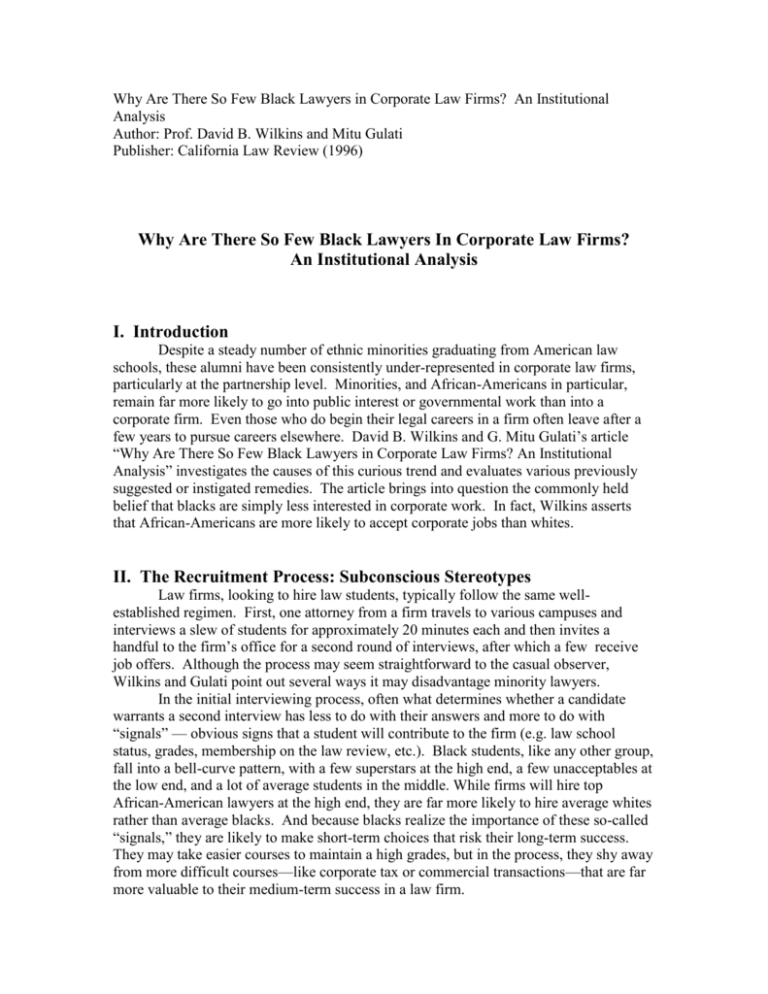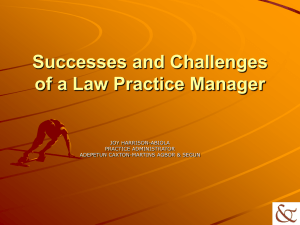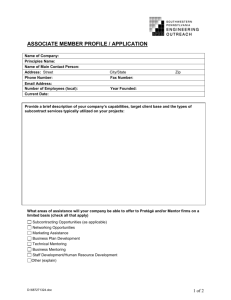this summary in Microsoft Word
advertisement

Why Are There So Few Black Lawyers in Corporate Law Firms? An Institutional Analysis Author: Prof. David B. Wilkins and Mitu Gulati Publisher: California Law Review (1996) Why Are There So Few Black Lawyers In Corporate Law Firms? An Institutional Analysis I. Introduction Despite a steady number of ethnic minorities graduating from American law schools, these alumni have been consistently under-represented in corporate law firms, particularly at the partnership level. Minorities, and African-Americans in particular, remain far more likely to go into public interest or governmental work than into a corporate firm. Even those who do begin their legal careers in a firm often leave after a few years to pursue careers elsewhere. David B. Wilkins and G. Mitu Gulati’s article “Why Are There So Few Black Lawyers in Corporate Law Firms? An Institutional Analysis” investigates the causes of this curious trend and evaluates various previously suggested or instigated remedies. The article brings into question the commonly held belief that blacks are simply less interested in corporate work. In fact, Wilkins asserts that African-Americans are more likely to accept corporate jobs than whites. II. The Recruitment Process: Subconscious Stereotypes Law firms, looking to hire law students, typically follow the same wellestablished regimen. First, one attorney from a firm travels to various campuses and interviews a slew of students for approximately 20 minutes each and then invites a handful to the firm’s office for a second round of interviews, after which a few receive job offers. Although the process may seem straightforward to the casual observer, Wilkins and Gulati point out several ways it may disadvantage minority lawyers. In the initial interviewing process, often what determines whether a candidate warrants a second interview has less to do with their answers and more to do with “signals” — obvious signs that a student will contribute to the firm (e.g. law school status, grades, membership on the law review, etc.). Black students, like any other group, fall into a bell-curve pattern, with a few superstars at the high end, a few unacceptables at the low end, and a lot of average students in the middle. While firms will hire top African-American lawyers at the high end, they are far more likely to hire average whites rather than average blacks. And because blacks realize the importance of these so-called “signals,” they are likely to make short-term choices that risk their long-term success. They may take easier courses to maintain a high grades, but in the process, they shy away from more difficult courses—like corporate tax or commercial transactions—that are far more valuable to their medium-term success in a law firm. During the second stage of the hiring process, the firm invites candidates to its office to undergo another round of interviews; however, the questions in this interview are not to test legal knowledge or skills but to determine how well an applicant would “fit” into the firm culture. Here, too, many minorities face an uphill battle. Wilkins and Gulati cite evidence that interviewers subconsciously favor people who look like themselves. Some white interviewers may feel less comfortable during interviews with blacks. This feeling might have a negative impact on their evaluations. III. Once Inside the Firm… Minorities Lack Mentors at Large firms The authors assert that a lack of mentors is one of the most significant reasons why minorities don’t make it onto the “fast track” to partnership. Law firms may hire a large number of associates each year, but only a handful of young lawyers receive the one-on-one attention, training, and mentoring that comes from being close to firm partners. Partners are also in a position to help young associates develop critical social relationships that lead to gaining new business. Those who aren’t selected by partners are left to do the more routine assignments. First, partners and senior associates are less likely to choose to mentor minority associates. Referring back to the notion of subconscious biases, partners and senior associates tend to mentor lawyers who remind them of themselves. Although this tendency is not inherently wrong, it can lead to a disproportionate number of talented lawyers, both women and minorities, feeling that they have no long-term prospects at the firm. Because they feel they have no reason to invest significant amounts of time and energy into the firm, they leave, and in doing so, reinforce the idea that women and minority lawyers aren’t interested in corporate work and, thus, are risky associates to mentor. It is a self-perpetuating cycle. Furthermore, when women and minority partners attempt to mentor young associates from similar backgrounds, this may be interpreted as unfairly “playing favorites” rather than rectifying a serious problem. Access to mentors is absolutely critical for law firms in their struggle to hold onto talented associates. A Mark Against One Is a Mark Against All Sociological studies have revealed that partners in the firm tend to club minority groups together, rather than assess them as individuals. That is, the performance of one African-American lawyer may influence the evaluation of the others. And because black associates are few and far between, any mistakes they make stand out in the minds of their colleagues and supervisors. This, in turn, causes black associates to be overly cautious, avoiding high-profile assignments or expanding their work experience. They may protect themselves from being fired in the short-run, but they never stand out and demonstrate that they are partnership material. IV. Strategies for Success Go Into Litigation! One area where African-American lawyers have done well in corporate firms is in litigation departments. In fact, this has been the most successful strategy for black lawyers. More than half of black lawyers at elite firms are litigators. Participating in a high-profile litigation case is an excellent way for minority associates to get noticed. Also, the skills required for litigation are highly marketable, increasing the associate’s value and outside career prospects. Associates may engage in litigious pro bono work, which gives them valuable training and may afford them the possibility of taking on real responsibility. However, litigation departments, like any other, are big, and associates will struggle to get noticed. Although the associates may engage in pro bono projects where they can take a leadership role and develop their litigation skills, this turn carries risk, as well: Lawyers who appear too keen on pro bono work will be seen as not demonstrating sufficient commitment to the “paying clients.” An Odd Pattern of Success: Leave the Firm Then Come Back Although there is a significant dearth of minority corporate partners, Wilkins has identified a pattern among those minorities who have made it to the partnership level. These attorneys often leave corporate firms, work in different fields—whether in an inhouse corporate legal department, a smaller firm, a financial services company, or even a government department—then they later return to corporate firms, bringing with them a wealth of knowledge, expertise, and social networks that become invaluable to the firm. Ironically, in leaving, minority lawyers gain the social networks, name recognition, and critical experience that make them partnership material for elite corporate firms. Pressure From Corporate Clients Wilkins discusses that two potential strategies are formal training programs that are available to all associates and hiring diversity consultants. But the most effective solution in expanding the numbers of ethnic minority lawyers in corporate firms has been the result of pressure from outside corporations that insist that a portion of their legal business be handled by minority attorneys. This works not just to ensure minorities get more substantive work, but also to entice law firms to hire more minority attorneys or risk losing business to firms that can put black lawyers on assignments at the request of corporations. During one such program’s first three years, the number of minority associates at participating firms increased by more than 50 percent, and the number of partners by 57 percent. Diversity Initiatives: The other helpful solution is for elite firms to make a genuine and substantial effort in hiring and retaining minority associates. Because women and minority associates realize that their odds of making partner are so much lower, they have less of an incentive to invest in strategies that will allow them to achieve long-term success at a firm. But as firms make special efforts to train and retain them, these lawyers feel that they now have a “ticket” to the fast-track, increasing their incentives to work Consequently, instituting diversity committees or special programs to highlight the benefits of investing in a longterm career at the firm is critical for women and minorities. However, there is always a risk that white-male associates will view such practices as unfair; however, as firms take more open and flexible approaches to determining who should be placed on the partnership track, women and minorities may benefit in the short term, but a more flexible stance toward promotion will spread to the entire firm, which will increase the incentive for all lawyers to stay at firms longer. Although retention issues are particularly acute for ethnic minority lawyers, all major law firms are struggling to retain their talented associates, regardless of race, religion, or gender. Firms that learn the lessons from the experience of African-American lawyers are in a key position to gain a competitive advantage over their competitors.









